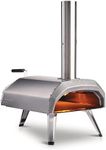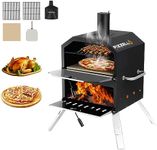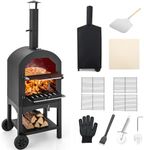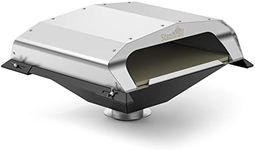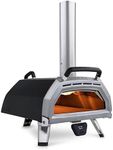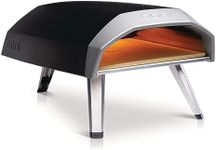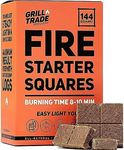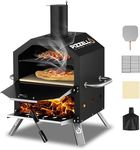Buying Guide for the Best Outdoor Pizza Ovens
Choosing the right outdoor pizza oven can make your backyard gatherings and family meals much more enjoyable. The key is to find an oven that matches your cooking style, space, and the types of pizzas or other foods you want to prepare. Understanding the main features and how they impact your experience will help you make a confident decision. Think about how often you’ll use the oven, how many people you usually cook for, and how much space you have available. By focusing on the most important specifications, you can find an outdoor pizza oven that fits your needs and helps you create delicious, restaurant-quality pizzas at home.Fuel TypeFuel type refers to what powers the pizza oven, such as wood, gas, charcoal, or a combination. This is important because it affects the flavor of your pizza, the convenience of use, and how quickly the oven heats up. Wood-fired ovens give a traditional smoky flavor and high heat, but require more effort to manage. Gas ovens are easier to control and heat up quickly, making them more convenient for frequent use. Charcoal offers a middle ground with some smoky flavor and easier control than wood. If you want authentic taste and enjoy the process, wood might be best. If you prefer quick, easy cooking, gas is a good choice. Consider your cooking habits and taste preferences when deciding.
Maximum TemperatureMaximum temperature is the highest heat the oven can reach, usually measured in degrees Fahrenheit or Celsius. This matters because traditional Neapolitan-style pizzas cook best at very high temperatures, often around 800°F (425°C) or higher, resulting in a crispy crust and perfectly cooked toppings in just a couple of minutes. Lower maximum temperatures are fine for other styles or for baking bread and roasting. If you want to make authentic, fast-cooked pizzas, look for an oven with a high maximum temperature. If you plan to cook a variety of foods or prefer slower cooking, a lower maximum temperature may be sufficient.
Cooking Surface SizeCooking surface size is the area inside the oven where you place your pizza or other food. This is important because it determines how large a pizza you can make and whether you can cook multiple items at once. Small ovens are great for personal pizzas and small gatherings, while larger ovens can handle family-sized pizzas or several at a time. Think about how many people you usually cook for and whether you want to make large pizzas or several smaller ones. Choose a size that matches your typical needs without taking up unnecessary space.
PortabilityPortability refers to how easy it is to move the pizza oven around. Some ovens are lightweight and designed to be portable, while others are heavy and meant to stay in one place. This is important if you want to take your oven to different locations, store it away when not in use, or have limited outdoor space. If you plan to use your oven in different places or want to store it easily, look for a portable model. If you have a dedicated outdoor kitchen or patio, a larger, stationary oven might be a better fit.
Build MaterialBuild material describes what the oven is made from, such as stainless steel, stone, or brick. This affects durability, heat retention, and how the oven looks in your outdoor space. Stainless steel ovens heat up quickly and are resistant to weather, making them easy to maintain. Stone or brick ovens retain heat longer and provide a traditional look, but they are heavier and may require more care. If you want something low-maintenance and modern, stainless steel is a good choice. If you value heat retention and classic style, consider stone or brick.
Heat-Up TimeHeat-up time is how long it takes for the oven to reach cooking temperature after you start it. This is important for convenience, especially if you want to make pizza on short notice. Some ovens heat up in as little as 10-20 minutes, while others may take an hour or more. If you prefer spontaneous cooking or have limited time, look for an oven with a short heat-up time. If you enjoy the process and don’t mind waiting, a longer heat-up time may not be an issue.

